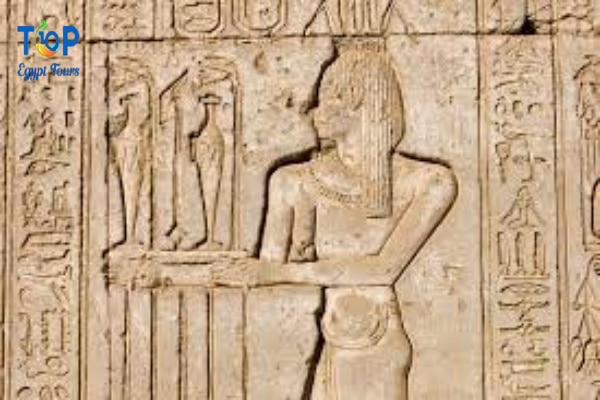The Splendor of Hapi: An Introduction to the Nile God of Fertility
Hapi Abundant Waters of the Nile God, Welcome to Top Ten Egypt Tours captivating journey into the realm of ancient Egyptian mythology! As we embark on this wondrous expedition, we invite you to discover the divine presence of Hapi, the revered god of fertility and the life force of the Nile River. Join us as we delve into the captivating tale of this extraordinary deity and unlock the secrets behind the abundant waters that have nourished Egypt for centuries.
Hapi Abundant Waters of the Nile God, the personification of the Nile River, played a vital role in ancient Egyptian culture, shaping the livelihoods of its people. The god represented the essence of fertility, a continuous source of life and prosperity for the land. Let us immerse ourselves in the captivating legends that surround Hapi, as we uncover the symbiotic relationship between this powerful deity and the Nile River.
The Dual Nature of Hapi: Nurturer of North and South
Hapi’s significance extended beyond simply being the god of the Nile River. He also embodied the unification of Upper Egypt (the South) and Lower Egypt (the North). In this duality, Hapi symbolized the harmonious merging of the two regions, their distinct cultures, and their reliance on the fertile waters of the sacred river.
The Egyptians believed that Hapi resided in two caverns—one in Aswan, which represented the source of the Nile’s waters in the south, and the other in Elephantine, symbolizing the river’s end in the north. The divine presence of Hapi in these locations ensured the continuous flow of the life-giving waters, sustaining the bountiful fertility that Egypt thrived upon.
Hapi as the Giver of Life: Fertility and Prosperity
Central to Hapi’s role was the responsibility of nourishing the lands along the Nile. The god’s embrace extended far beyond the river itself, spreading the gifts of fertility and abundance to the fertile floodplains, which were vital for successful agriculture. The annual flooding of the Nile, believed to be a result of Hapi’s influence, replenished the soil and allowed crops to flourish, creating a prosperous environment for the Egyptian people.
Egyptians recognized the importance of gratitude to Hapi for his role in the fertility of the land. Ceremonies, rituals, and offerings were conducted to honor the god and ensure that the life-giving waters would continue to flow abundantly. Egyptians believed that the overflowing waters were Hapi’s way of bestowing blessings upon them, promising a prosperous year ahead.
Symbolism and Depictions of Hapi Abundant Waters of the Nile God: The Iconic Blue-Green God
Hapi’s depictions in the ancient Egyptian artwork hold great significance. The god was often portrayed as a plump, bearded figure with blue-green skin—an iconic representation of the fertile river itself. His ample belly symbolized the abundance of the Nile’s floodwaters, while the water plants adorning his head embodied the thriving vegetation that blossomed along the riverbanks.
The blue and green hues associated with Hapi reflect the primeval waters and the regenerative power they held. These depictions served as a visual reminder of the god’s benevolence and the eternal cycle of life he embodied. Today, these artistic representations can be found in temples and tombs, reminding visitors of the enduring legacy of Hapi and the vital role he played in Egypt’s agricultural prosperity.
Temples and Offerings to Hapi: Honoring the Divine Provider
The divine significance of Hapi was reflected in the grand temples dedicated to his worship. One of the most notable temples was built on Elephantine Island, where Hapi’s presence was believed to be the strongest. Here, devotees would gather to honor, praise, and offer gifts to the god, expressing their gratitude for the abundant blessings bestowed upon the land.
The offerings made to Hapi included food, drink, and precious artifacts, symbolizing the offerings made during the annual flooding of the Nile. These rituals reinforced the sacred bond between the Egyptian people and the god of fertility, ensuring the preservation of their livelihoods and the continuity of the abundant waters that sustained their communities.
Experiencing the Legacy of Hapi: A Journey through Ancient Egypt
To truly immerse yourself in the richness of Hapi’s legacy and the enchanting world of ancient Egyptian mythology, we invite you on a remarkable voyage through Egypt’s historical sites. From the majestic temples dedicated to Hapi to the breathtaking landscapes that bear witness to the Nile’s bounty, every step will unveil the profound connection between the god and the lifeline of Egypt.
Explore the temples of Kom Ombo and Philae, where Hapi’s presence resonates deeply within the intricate carvings and divine symbolism. Witness the grandeur of the temples of Luxor and Karnak, where the powerful stories of Hapi and the Nile River come to life. Let the timeless allure of the Valley of the Kings and the mesmerizing beauty of the Nile Delta guide you on a pilgrimage that will transport you to an era of spiritual connection and abundance.
Hapi, the revered god of fertility and the life force of the Nile River, holds an indispensable place in ancient Egyptian mythology. As the nurturer of North and South, Hapi’s abundant waters sustained Egypt’s prosperity and symbolized the harmonious coexistence of its land and people. Today, the legacy of Hapi lives on through awe-inspiring temples, intricate artwork, and the enduring reverence for the transformative power of water. Join us on a journey through Top Ten Egypt Tours captivating exploration of this remarkable deity, and witness the profound connection between Hapi, the Nile, and the extraordinary civilization that flourished upon its fertile shores.



Comment (0)